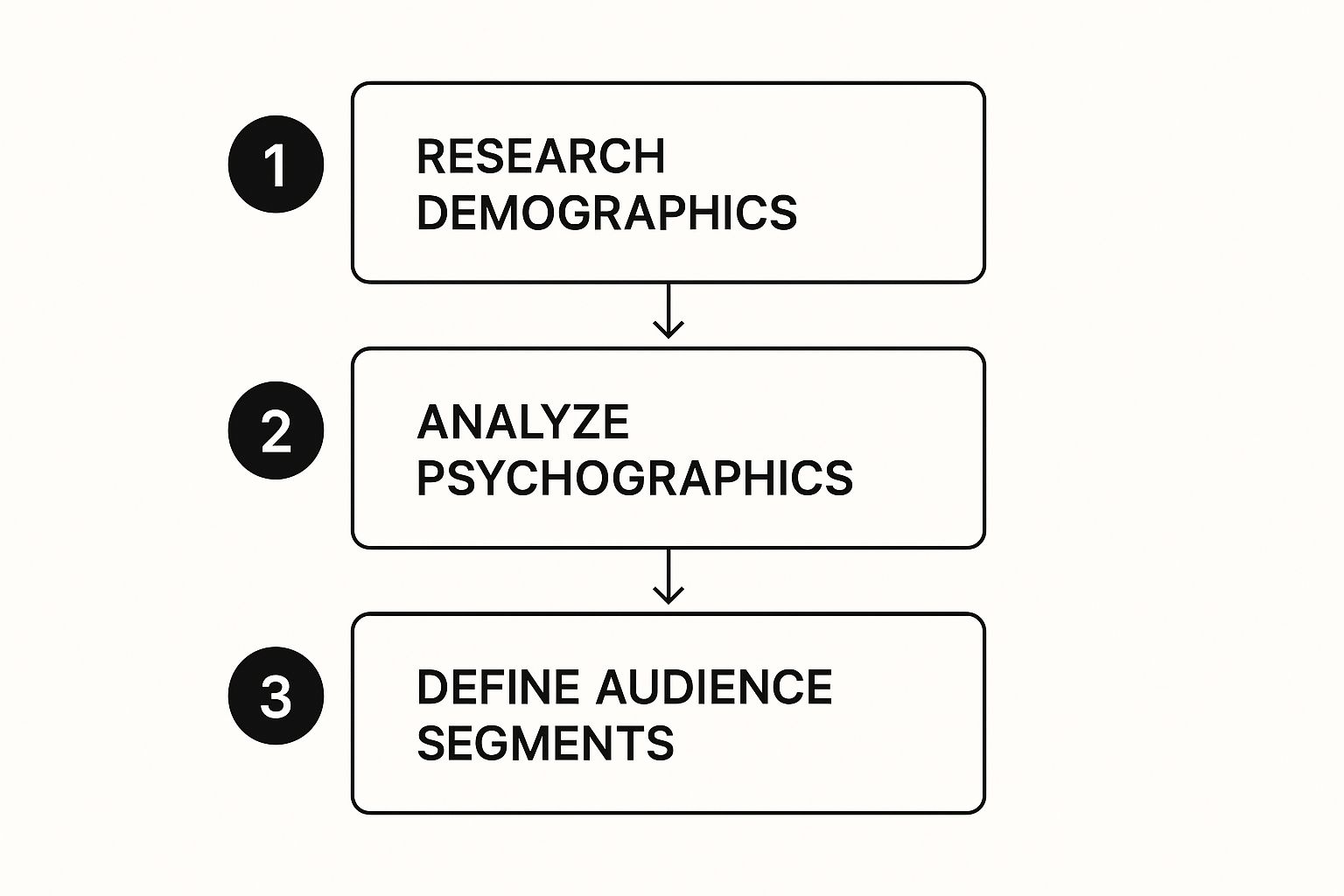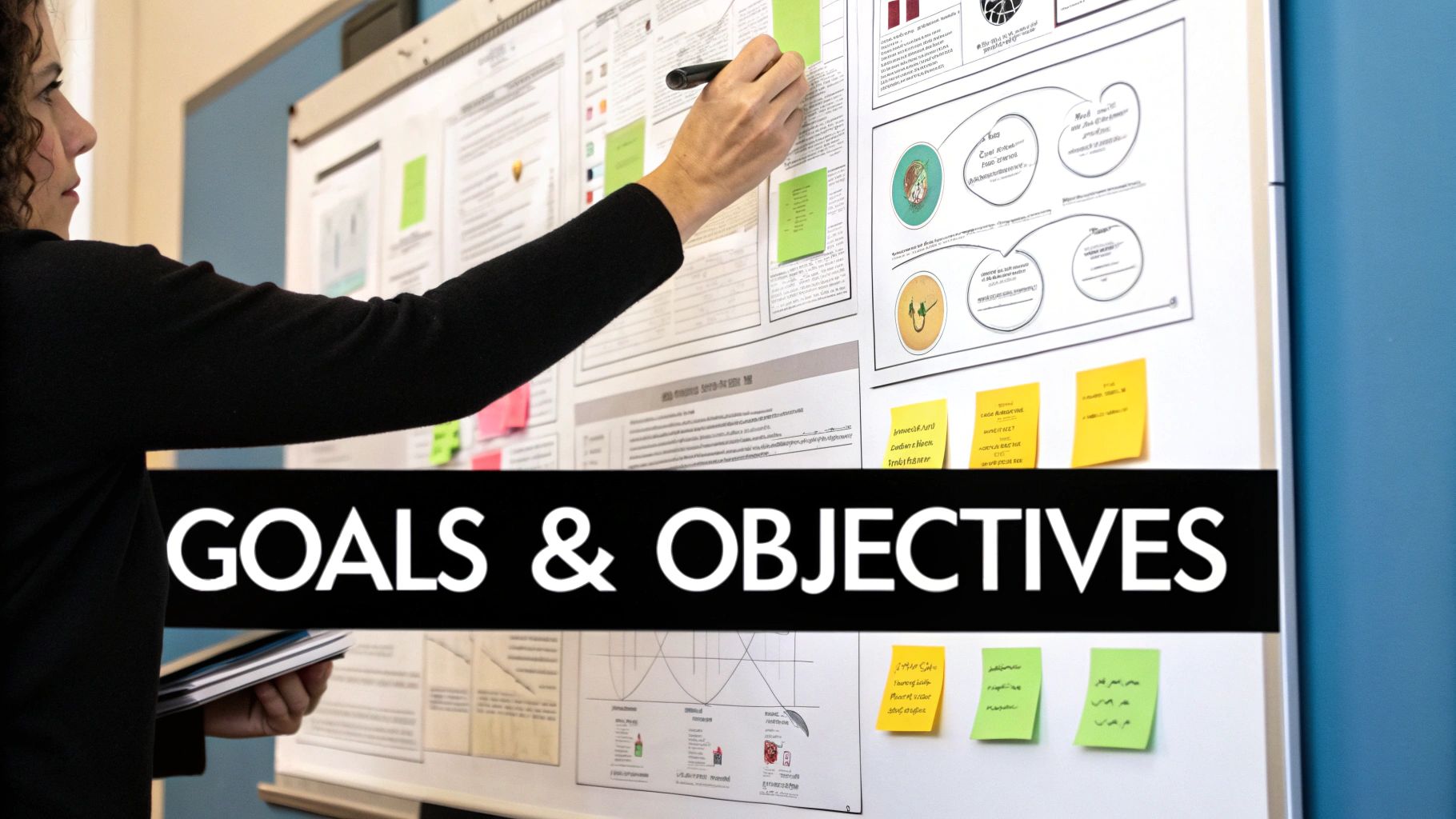A marketing brief is the absolute foundation of any project. It's the document that lays out all the critical details—the project's main goals, who you're trying to reach, and exactly what needs to be delivered.
Think of it as the blueprint for your entire campaign. It’s the single source of truth that gets everyone, from stakeholders to your creative team, on the same page and rowing in the same direction. When done right, it stops miscommunication in its tracks and keeps projects from going off the rails.
Why Projects Fail Without a Strong Marketing Brief
Trying to launch a marketing campaign without a clear brief is like setting sail without a map. Sure, you might have a vague idea of your destination, but the journey will be a mess of confusion, wrong turns, and wasted time and money. I've seen it happen time and again: projects don't fail because the team lacks talent. They fail because they lack alignment.

When teams are forced to work from hazy instructions or casual verbal agreements, the result is predictable chaos. Designers create visuals that clash with the copywriter's tone, and the final product feels disjointed and completely off-brand. This isn't just an aesthetic hiccup; it has real, tangible costs to the business.
The Real Cost of Bad Briefs
When there's no central document to guide decisions, projects run into some pretty serious problems that hit the bottom line hard. These issues pile up, creating a frustrating and expensive mess for everyone involved.
The consequences of a vague or nonexistent brief can be painful. Endless revisions, blown budgets, and a final product that just doesn't connect with your audience are all too common.
| Challenge | Impact of No Brief | Benefit of a Strong Brief |
|---|---|---|
| Scope Creep | Unclear goals lead to constant "can we just add…" requests, derailing timelines. | The scope is locked in from the start, preventing unexpected changes. |
| Budget Overruns | Every revision cycle adds up, burning through the budget with extra hours and resources. | Projects are 40-50% more likely to stay on budget. |
| Wasted Time | Teams spend more time debating what to do than actually doing it, causing major delays. | Everyone knows their role, leading to faster execution and on-time delivery. |
| Team Frustration | Creative talent gets demoralized by rework and conflicting feedback. | Teams feel empowered and confident, producing their best work. |
| Poor ROI | The final campaign misses the mark with the target audience, leading to weak results. | Creative is laser-focused on the right audience, driving better engagement and ROI. |
Simply put, the upfront work of creating a solid brief saves you from a world of hurt down the line.
A great marketing brief acts as your project's constitution. It sets the rules of engagement, defines what success looks like, and gives your creative team the clarity they need to knock it out of the park.
The Power of a Standardized Template
This is where a standardized marketing brief template becomes a game-changer. It brings instant structure and efficiency to your workflow. The proof is in the numbers: 76% of marketers say that a detailed brief is the key to increasing their project success rates.
A well-crafted brief is the ultimate communication tool. It forces stakeholders to really think through their objectives and put them down on paper before any work kicks off. This initial investment in planning pays for itself many times over by preventing costly mistakes.
Ultimately, it ensures your final campaign is cohesive, on-target, and ready for success. If you're looking for more data on this, checking out some small business marketing statistics can really highlight why structured planning is so critical.
Anatomy of an Effective Marketing Brief Template
A truly great marketing brief template is so much more than a fill-in-the-blanks document. It’s a strategic roadmap. Every single section plays a critical role, guiding the creative team from a vague idea to a tangible, on-target result.
Think of it like building a house. If you skimp on the foundation—say, the project background or the audience profile—you're guaranteed to find structural weaknesses in your final campaign. It’s inevitable.
Let’s pull back the curtain and look at the essential pieces that turn a simple document into a powerhouse for alignment and creative inspiration.
Setting the Stage with a Project Background
This is your campaign’s origin story. It’s where you give everyone, especially creative partners who weren't in those initial strategy meetings, the crucial context they need. In short, this section needs to answer one simple question: Why this project, right now?
Forget the generic company history nobody reads. Instead, get right to the point. Focus on the specific business challenge or opportunity that sparked this whole thing.
- The Problem: Are your sales tanking with a key demographic?
- The Opportunity: Is there a new market trend you can jump on before anyone else?
- The Goal: Is this project meant to support a huge new product launch or a major brand refresh?
For example, a weak background might just say, "We want to run a new social media campaign." A strong one gets specific: "Our Q2 analytics show a 35% drop in engagement among users aged 18-25. This campaign needs to reverse that trend by re-engaging this audience with content that speaks their language before our new youth-focused product line launches in Q4." See the difference?
Defining the Target Audience with Precision
Everyone knows "know your audience" is marketing 101. But just listing demographics like age and gender isn't going to cut it anymore. Not if you want to create work that actually connects. You have to dig into the psychographics—their attitudes, their interests, their values, their lifestyles. This is how you get from who they are to why they do what they do.
A killer audience profile in your brief should answer questions like:
- What are their biggest goals and their most annoying frustrations?
- What media do they actually consume? Who do they trust for advice?
- What does a Tuesday look like for them, from morning to night?
- How do they really feel about our brand? And what about our competitors?
This infographic breaks down a simple way to build out a rich audience profile.

As you can see, moving past basic demographics to truly understand what makes your audience tick is what allows for sharper, more relevant creative work.
Crafting SMART Objectives for Clear Direction
"Increase brand awareness" isn't an objective. It's a wish. For a brief to actually work, its goals must be SMART: Specific, Measurable, Achievable, Relevant, and Time-bound. This simple framework forces you to get crystal clear and establishes a definitive finish line for the project.
Every single person on the team, from the copywriter to the media buyer, should know exactly what success looks like in real numbers.
| Vague Objective | SMART Objective |
|---|---|
| Get more leads. | Increase qualified marketing leads from our website by 15% over the next 3 months. |
| Improve our social media. | Grow our Instagram follower count by 2,500 new followers and achieve an average engagement rate of 4% by the end of Q3. |
| Sell more products. | Drive $50,000 in online sales for our new shoe line within the first 60 days of the campaign launch. |
These sharp, specific goals kill ambiguity and give the team concrete targets to rally behind. It also makes measuring performance down the line a whole lot easier.
The Core Message and Competitive Landscape
Okay, you know who you’re talking to and what you want to achieve. Now, you have to decide what to say. The core message is the single most important idea you want to get across. It’s the one thing that, if the audience forgets everything else, they will remember. Keep it simple, compelling, and unique to your brand.
To really sharpen that message, you have to know what everyone else is saying. You need to map out the competitive landscape.
A great brief doesn't just look inward at the company's goals; it looks outward at the market. Understanding what competitors are saying helps you find a unique space to own in the consumer's mind.
Make a list of your top 2-3 direct competitors. What are their main messages? What are their strengths and, more importantly, their weaknesses? Finding a gap in their messaging can reveal a powerful angle for your own campaign. If you want to dig deeper into this kind of strategic thinking, a solid social media marketing plan template can provide some excellent context.
Detailing Deliverables, Budget, and Timeline
This is the logistical heart of the brief—where strategy becomes a concrete plan. Any ambiguity here leads straight to scope creep, missed deadlines, and blown budgets.
- Key Deliverables: Be painfully specific. Don't write "social media assets." Instead, write: "Five 15-second video ads for Instagram Reels, three static image posts for Facebook, and corresponding ad copy for each."
- Budget: Lay out a clear, all-inclusive budget. This needs to cover everything: production, ad spend, talent fees, and any other cost you can think of.
- Timeline: Outline the key milestones and hard deadlines. Put dates on the calendar for the creative kickoff, first-draft reviews, final approvals, and the big campaign launch.
While a marketing brief is all about a specific campaign, the principles of clarity and structure are universal. For those managing the creative work that comes from the brief, our guide to building a creative brief template is the perfect companion piece. It helps ensure every single stage of the process is built on a rock-solid foundation.
Writing a Brief That Inspires Incredible Creative

Look, having a solid marketing brief template is a great starting point. But a template is just a container—a set of empty boxes. What you put inside those boxes is what separates a forgettable campaign from one that people actually talk about.
This is where your job shifts from project manager to storyteller. The goal isn't just to inform the creative team; it's to genuinely inspire them. You need to give them clear guardrails without making them feel like they're in a creative straitjacket. It's a delicate balance, but getting it right is where the magic happens.
Capture Your Brand's Personality and Tone
This is one of the most powerful things you can nail down in a brief. It’s what turns a generic marketing message into something with a real, memorable personality. Vague words like "friendly" or "professional"? They’re not enough. They’re background noise.
You have to get specific. Think in terms of vivid adjectives and real-world analogies that your team can actually feel and work with.
Try framing it this way:
- If our brand were a person, who would it be? Are they the quick-witted friend who always has a clever comeback? Or the wise, dependable mentor you turn to for advice?
- What's our brand's sense of humor? Dry and sarcastic? Goofy and lighthearted? Or maybe it’s not funny at all, aiming instead for a tone that’s more serious and aspirational.
- Show, don't just tell. Drop in links to past campaigns—yours or even a competitor's—that hit the exact vibe you're going for.
Saying you want a tone that’s "Confidently Casual, like a tech founder presenting in a hoodie and sneakers" gives your team so much more to work with than just "modern and approachable."
The Single Most Important Thing
If your audience could only remember one thing from this campaign, what would it be? This is your North Star. It’s often called the "Single Most Important Thing" (SMIT) or the key message.
Here’s the hard truth: trying to cram three or four ideas into one campaign is a surefire recipe for a muddled, ineffective mess.
Your brief must be ruthless in its focus. A great brief makes a choice. It doesn't ask the creative team to say everything; it tells them the one thing that must be said, felt, and remembered.
This isn't just about what you want people to know. It's about what you want them to feel or do.
| Weak SMIT (Too Broad) | Strong SMIT (Focused and Emotional) |
|---|---|
| Our new software is efficient. | Our software gives you back an hour of your day, so you can leave work on time and be present with your family. |
| We sell high-quality coffee. | The first sip of our coffee feels like the start of a perfect weekend, no matter what day it is. |
This single-minded focus is what your creative team will rally around. Every image, every line of copy, every second of video—it all gets measured against the SMIT. If it doesn't reinforce that one core idea, it gets cut.
Provide Inspiration Without Being a Dictator
One of the fastest ways to kill creativity is to be too prescriptive. You hired creative professionals for a reason—for their ideas and expertise. Your brief should be a launchpad, not a paint-by-numbers kit.
This is especially true with visual direction. Please, avoid directions like, "We need a picture of a smiling family on a beach." You're leaving zero room for a more powerful, original concept to emerge.
Here’s a much better way to guide them:
- Curate a Mood Board: Jump on Pinterest or just throw together a slide deck. Collect images, colors, textures, and fonts that evoke the feeling you're after. This gives a sense of the aesthetic without dictating the final shot list.
- Use "Mandatories & No-Goes": Be crystal clear about the absolute must-haves (e.g., "logo must always appear on a white background") and the things you want to avoid at all costs (e.g., "no cheesy stock photos of people in suits").
- Describe the Vibe: Use words to paint a picture. "We want the visuals to feel optimistic and airy, full of natural light. Think a palette of soft pastels and earthy tones."
This approach gives your creative team the direction they crave while still respecting their talent to find the best possible solution. Getting this balance right is a huge part of the process, and you can get even more advice on how to write a creative brief that your team will actually love reading.
Defining and Measuring Real Campaign Success
A beautifully written brief that inspires incredible creative is only half the battle. Seriously. If you don't clearly define what victory looks like—in real, measurable terms—your campaign is just a shot in the dark.
This is where you stop talking about fuzzy goals and start talking about tangible Key Performance Indicators (KPIs). This part of your marketing brief template is all about accountability. It gives everyone on the team, from the copywriter to the media buyer, a shared understanding of the finish line. It turns vague hopes like "getting more engagement" into concrete targets we can all work toward.
Ultimately, this is how you prove your campaign’s actual business value.
Moving Beyond Vanity Metrics
First things first: we need to separate the metrics that make us feel good from the metrics that actually matter to the business. A spike in post likes is a classic vanity metric. It's nice, but it doesn't directly translate to revenue or growth. True KPIs are always tied directly to your core business objectives.
For instance, if your main goal is lead generation, the number of impressions your ad gets is far less important than your cost per qualified lead. If you're launching a new product, tracking website visits is fine, but what really counts is the conversion rate from the landing page to an actual sale.
A successful brief forces a conversation about what truly defines success before a single dollar is spent. It's the difference between celebrating 10,000 likes and celebrating 100 high-quality leads that turned into new customers.
This isn't just a hunch; the data backs it up. A global survey showed 68% of marketing managers believe clear objectives are the number one driver for successful campaigns. On top of that, 59% of professionals said that briefs helped them measure ROI by defining these goals upfront—something many marketers struggle to do.
Matching KPIs to Campaign Objectives
Not all campaigns are created equal, so your KPIs shouldn't be either. You can't just copy and paste them from one project to the next. Trying to apply e-commerce metrics to a brand awareness campaign is a recipe for confusing data and poor decisions. The metrics you choose have to align perfectly with the specific goal of your project.
Here’s a quick cheat sheet for how I think about matching KPIs to common campaign types:
- For Brand Awareness: The goal here is pure reach and recognition. Your brief should focus on metrics like reach, impressions, video view-through rate, and share of voice.
- For Lead Generation: Now we're talking about capturing potential customers. Key metrics include cost per lead (CPL), form submission rate, click-through rate (CTR) on your calls-to-action, and the number of marketing qualified leads (MQLs) you generate.
- For Sales and Conversions: This is all about the bottom line. Track metrics like return on ad spend (ROAS), customer acquisition cost (CAC), average order value (AOV), and the overall e-commerce conversion rate.
When you detail these specific KPIs in your brief, you're creating a clear scorecard for the campaign. When it's all over, there's no debate about whether it was a success. You have the data to prove it.
Setting Benchmarks and Targets
Okay, so you've picked the right KPIs. The next step is setting realistic targets. This gives your team a specific goal to aim for. Without a target, a metric is just a number without context. Is a 4% engagement rate good? Bad? Who knows! It depends entirely on your industry and past performance.
Here’s a simple process for setting targets that actually mean something:
- Look at Your History: What were your average CPL or CTR on similar campaigns? Your own historical data is the best place to start. That's your internal benchmark.
- Do Some Industry Research: A quick search can often reveal average conversion rates or engagement benchmarks for your specific industry. See how you stack up.
- Define a Clear Goal: Don't just "hope for the best." Aim for a specific, measurable improvement. A target like, "Increase landing page conversion rate from 2.5% to 4%" is clear, actionable, and rallies the team.
Outlining these targets in the brief ensures everyone is aligned from day one. It creates a solid foundation for analyzing results and, most importantly, justifying the campaign's ROI. For a deeper look at this, our guide on how to measure project success has some great frameworks.
At the end of the day, using data-driven marketing insights is non-negotiable for defining and measuring what success truly looks like for your campaigns.
Right, so you get the theory. But theory doesn't get the project done. To actually get things moving, you need a solid starting point.
That’s why we’ve put together a fully customizable marketing brief template for you. This isn’t just some random document; it’s a practical tool we built based on everything we've talked about so far.

You can grab it as a Google Doc for easy team collaboration or a classic Word file if that’s more your speed. The whole point is to give you something you can plug in and use today, bringing much-needed structure and clarity to your next big thing.
Snag Your Template
Now, to really show you how it works, we’ve also filled out a couple of examples. These are based on real-world scenarios to show you how to turn those blank fields into a powerful, strategic guide. It’s one thing to know what goes in the box, but seeing it in action is what makes it click.
A blank template gives you the framework, but a filled-out example provides the context. Use ours to see how raw info about goals, audiences, and KPIs gets shaped into an inspiring and actionable brief.
Example 1: Digital Product Launch
First up, we've got a brief for launching a new project management mobile app. This one is all about hitting the ground running and making a big splash right away to grab that early market share.
- The Big Goal: Hit 10,000 downloads and lock in a 4.5-star app store rating within the first 60 days.
- Who We're Talking To: Tech-savvy freelancers and small agency owners who are totally overwhelmed by clunky, enterprise-level software.
- The Core Message: "The power of a big agency, simplified for your small team."
This example gets specific on the deliverables, mapping out everything from app store preview videos to highly targeted social ads. It also nails down the KPIs for tracking success, like cost per install (CPI) and the user retention rate after week one.
Example 2: Service-Based Brand Awareness
Our second scenario is for a local accounting firm that wants to stop being a hidden gem and become the go-to expert for startups. Here, the goal isn't about immediate sales; it’s about building authority and trust.
- The Big Goal: Bump up website traffic from organic search by 40% and land three guest spots on local business podcasts in the next six months.
- Who We're Talking To: First-time founders in the local tech scene. They need financial guidance but are pretty intimidated by the old-school, suit-and-tie firms.
- The Core Message: "Your startup's financial co-pilot."
You'll see this brief leans heavily into content marketing—think blog posts and a downloadable tax guide—to build that all-important credibility. Seeing how these different types of goals are defined and tracked will make you much better at measuring your own campaign performance metrics, no matter what you're trying to achieve.
Common Questions About Marketing Briefs
Even with a rock-solid marketing brief template in your hands, questions always seem to bubble up when you start putting a new process into play. Let's be honest, getting your whole team and all the stakeholders on board requires some real clarity and confidence.
So, let's get into some of the most common hurdles I've seen pop up time and time again. Working through these will help you navigate the transition smoothly and turn your template from just another document into a tool everyone actually wants to use.
How Much Detail Is Too Much?
Ah, the classic tug-of-war. You need to provide enough detail for clear direction, but not so much that you completely suffocate the creative team. I've found the sweet spot is giving the "what" and the "why," but leaving the "how" wide open for them to work their magic.
Think of it this way: you’re providing a destination and some key landmarks, not turn-by-turn driving directions.
- Do provide: The core business challenge, a sharp SMART objective, and a real deep dive into the target audience’s world and mindset.
- Don't provide: Exact headline copy, specific stock photo selections, or super prescriptive layouts. Your job is to set the stage, not direct the entire play.
Here's a good rule of thumb I use: ask yourself if a piece of information opens up creative doors or slams them shut. If it's the latter, it probably doesn't belong in the brief.
The best briefs I've ever seen are concise but incredibly comprehensive. They inspire by giving a laser-sharp strategic focus, not by burying creatives under a mountain of executional notes. Give them the problem, the goal, and the guardrails—then get out of the way and trust them to find the solution.
Who’s Actually Responsible for the Brief?
This one is critical. Without clear ownership, the brief will inevitably fall through the cracks. While it's definitely a team effort, one person has to be the one holding the pen and owning the final document.
Typically, that responsibility lands with the account manager, project manager, or brand manager—whoever is closest to the business goals and stakeholder needs.
A workflow that I've seen work really well looks something like this:
- The Write-Up: The project owner (let's say a brand manager) gathers all the intel from stakeholders and bangs out the first draft.
- The Gut-Check: That draft then gets shared with key players—like the creative lead and media strategist—to get their input and flag any red flags or confusing points.
- The Sign-Off: Finally, the main stakeholder (like a CMO or department head) gives it the final approval. This locks the brief in and makes it the official source of truth for the project. No more "he said, she said."
This simple process makes sure everyone is on the same page before a single dollar is spent or a single pixel is pushed.
Can I Just Use the Same Template for Every Single Project?
Yes… and no. The core skeleton of your marketing brief template—with its sections for objectives, audience, and KPIs—should absolutely stay consistent. That consistency is what makes your process efficient and predictable for the whole team.
However, you have to be willing to adapt it based on what the project actually is. A brief for a massive, multi-channel brand launch is going to need a much beefier "Competitive Landscape" section than a brief for a small run of social media ads. It just makes sense.
For instance:
- For a video project: You might add a dedicated section for "Key Visual & Audio Cues" or a "Mandatory Call-to-Action End Card."
- For an influencer campaign: You’d definitely want to add sections for "Influencer Vetting Criteria" and "FTC Disclosure Requirements."
The trick is to have a master template that acts as your foundation. From there, empower your team to add or emphasize sections as needed. This flexible approach is at the heart of effective creative project management that can actually adapt to the real world.
How Do I Get Buy-In from Super-Busy Stakeholders?
This is often the biggest mountain to climb. You’ve built this amazing new process, but getting busy executives and overloaded team members to actually adopt it can feel impossible. The secret is to talk about it in terms of the benefits they care about.
Forget talking about how it makes your life easier. Talk about how it protects the business.
- For Executives: Frame the brief as a risk-management tool. A signed-off brief is what prevents projects from going over budget and ensures the final work is directly tied to business goals. It's about maximizing ROI.
- For Creative Teams: Position it as their shield. A clear brief protects them from those soul-crushing, endless feedback loops and the dreaded "I'll know it when I see it" comments from stakeholders.
- For Other Departments: Explain it as their guarantee. It's a way to ensure their needs are heard and documented from day one, which cuts down on miscommunication and headaches for everyone.
My advice? Start with a pilot project. Pick one upcoming campaign and commit to using the brief from start to finish. Once people see firsthand how it eliminates chaos and leads to a better result, faster, they'll become your biggest champions.
At Creativize, we believe that clear communication is the bedrock of brilliant creative work. Our platform is designed to connect you with top-tier talent and provide the resources you need to manage your projects with clarity and confidence. Start building better campaigns today by finding the right creative partners at https://creativize.net.

